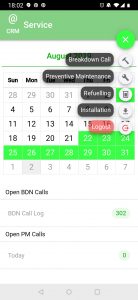When we built the service CRM– we had some very straightforward goals. Some have been achieved, some will be achieved down the road.
Let me do a quick roadmap sharing and also list the design objectives.
Design goals
- It must help manage entire “out of our gates” processes that customers need to handle- sales and support. We wanted sales to talk to support team and support teams to talk to sales- yet not get in each other’s way.
- You would notice that if you are going to sign up for a new account, then you can choose to sign up for a “Sales CRM”, “Service CRM” or a “Sales and Service CRM”. Why did we do it this way? Because for many of you, you are going to use a CRM for Sales or Service and getting you to use the complete Sales and Service CRM will only clutter your view. But for those who want their entire sales and service teams on the CRM platform, choose the Sales and Service CRM option. That’s the version which offers the entire flow from pre-sales to post sales.
- It must be much more than a helpdesk software. So, we were not only content with logging a service ticket, assigning it to an “agent” and waiting for a closure report. We wanted a software which helped answer questions like:
- who visited the site for repair.
- what did he do at site to solve the problem; root-cause and remedies.
- what spares were used.
- More than simple incident management. Sure, the software would handle ad-hoc incidents (breakdown or corrective maintenance cases. But we also wanted it to handle scheduled maintenance (preventive) and even cases for installation.
- In addition, the software has added the ability to periodically refuel (or refill) your field installed assets.

- It must be able to handle ALL types of products which need to be maintained. When we say all, we mean all. Software, hardware, consumer goods, capital goods, complex engineering products. Oh, and yes, it must handle a mix of product types that you are servicing.
- For example, let us say you are a “3rd party maintenance service provider”. You are maintaining laptops, desktops, printers and servers in customer premises spread all over a city or a state or a country. You should be able to configure the software to handle different maintenance schedules for laptops and printers.
- Also, you should be able to use predictive algorithms to forecast when your equipment at site might need preventive maintenance or refueling. And, you should be able to define the parameters based on your product types.
- This must be very very customizable. We wanted the user to have a lot of say on what information to capture and where.
- The service CRM must work on the web as well as a mobile app.
No code customization
We honestly believe that enterprise software is complex- it needs efforts from the users to mould it to their workflows. And, we get demands for customization often.
On the service CRM- the user- that is you, who does the customization. All from the UI. No coding needed.
Our vision was that no two Saleswah CRM implementations are ever going to be the same. All the pages will look different, their products will be different and so will their scheduling.
Let us know if we succeeded. Sign up for a free trial or ask for a demo.

